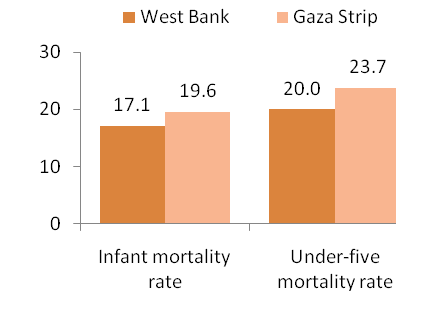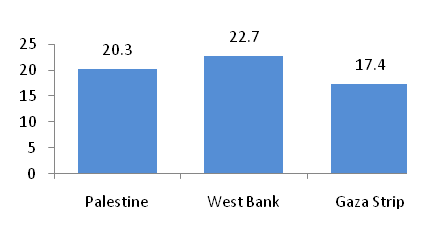The Palestinian Central Bureau of Statistics (PCBS) Issue a Press Release on the Occasion of International Health Day 07/04/2016
World Health Day 2016
The World Health Day, an opportunity for the revitalization of the work to protect people's health and well-being. Each year the World Health Organization chose a theme for the World Health Day to focuses on the public health issues that affect the international community, this year's theme entitled "Diabetes". The world health day is also an occasion to launch a health and awareness programs in various aspects of health.
Child Survival
One of the overarching goals of the Millennium Development Goals (MDGs) was to reduce infant and under-five mortality. Specifically, the 4th goal of MDGs calls for the reduction of under-five mortality by two-thirds between 1990 and 2015. Monitoring progress towards this goal is an important but difficult objective
Child mortality have decreased significantly from Under five Mortality Rate of around 42 in 1991 to the rate of around 22 per 1000 live births in 2014, and Infant Mortality Rate have decreased of around 32 in 1991 to the current rate of around 18 deaths per 1000 live births.
Infant and Under-five Mortality Rate, 2014

Malnutrition
Under nutrition causes more than half of all child deaths worldwide. Undernourished children are more likely to die from common childhood illnesses and those who survive fall sick frequently and have poor growth.
In Palestine, about 7 of 100 children under-five years old are stunted (too short for their age). Stunting is a reflection of chronic malnutrition as a result of failure to receive adequate nutrition over a long period and recurrent or chronic illness.
Fertility Rates
The total fertility rate in Palestine was 4.1 births per woman. The adolescent birth rate (Age-specific fertility rate for women age 15-19) in Palestine were 48 births per 1000 women.
Reproductive Health
Continuum of reproductive and maternal health, Palestine, 2014

Use of family planning methods and Unmeet needs
More than half of married women aged 15-49 years in Palestine used a family planning method (57.2%) in 2014. 59.9% of currently married women aged 15-49 years in rural areas used contraceptives, which is a higher rate in comparison to women in urban areas and camps, (56.6% in urban areas and 57.6% in camps).
Based on the Palestinian multiple cluster survey 2014 results, more interventions are needed in the area of family planning especially the demand for contraception satisfied, where 11% of women have an unmet need for family planning.
Caesarean Births
Most births in Palestine occur in health institutions, where 99.3% of births took place in health institutions. Data additionally indicated that 20.3% of births in Palestine.
Caesarean Births

Post-natal Care
90.7% of women 15-49 years received health care after birth, both during their stay in the health institutions or at home after birth or during a visit to post-natal care within two days of birth. data also showed that 93.9% of births received health check, either while in the health facility, or at home after birth, or received health care after childbirth within two days after birth.
Health of the youth (15-29) years old.
Difficulty/ disability
Youth survey data of 2015 showed that the percentage of young persons (aged 15-29) have difficulty/ disability was 3.7%, being 3.6% in the West Bank and 3.7% in the Gaza Strip. The percentage of male with difficulty/ disability was 4.9% compared to 2.3% or females.
Smoking
Data also showed that 23.5% of young persons are smoking, being 29.5% in the West Bank and 14.9% in the Gaza Strip. Gender variances were high with 40.9% of males smoking compared to 5.4% of females.
Daily sport exercising
Almost a quarter of youth (24.6%) reported they exercised daily for at least half an hour, at the rate of 19.6% in the West Bank and 32.6% in the Gaza Strip. Gender variance was high with 32.0% of males exercising compared to 17.0% of females.
 عربي
عربي